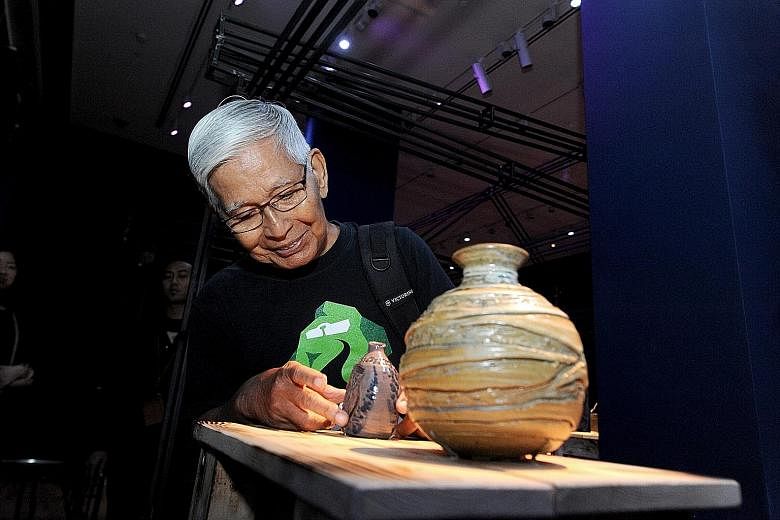Can art be useful? How often has one stepped into an art museum where the artworks are displayed on walls, pedestals and showcases beyond the reach of the visitor, stripped of their functionality, only to be admired from a distance?
Museums displaying functional artefacts like ceramic wares, including pots and plates, have emptied these objects of their utility, separated them from their cultural and social contexts, and reduced them to artworks to be appreciated only for their aesthetic rather than functional qualities.
Iskandar Jalil, who was designated a Master Potter by his Japanese sensei (teacher), continues to refer to himself as such rather than an artist and offers an expanded notion of art that includes the values, integrity and ethics of the potter as an inseparable part of the aesthetics of ceramic art.
The first major survey of the Cultural Medallion recipient's work opened at the National Gallery this week. Drawing on close to 180 works from the 1960s till today, the exhibition traces the journeys and diverse cultural sources which inform his practice.
Pottery can be said to be an "intimate material" as it communicates through feeling or touch. Iskandar draws from different pottery traditions, such as the Mingei movement or "arts for the people", a modern craft movement that began in the 1920s and sought to uphold the standards of craft production which were under threat due to industrialisation. Mingei recognises beauty in everyday, ordinary and utilitarian objects made by individuals. The movement strives for simplicity in pottery and that is why Iskandar seeks to avoid making a pot that is overly constructed.
He has stated that he has "spent a lifetime in search of an ethical pot". What is this ethical pot?
 The textures of Iskandar's pots stand out because they are made from local rather than commercially available clay. He would scour Singapore for the material, even taking samples from unconventional places. ST PHOTO: AZMI ATHNI
The textures of Iskandar's pots stand out because they are made from local rather than commercially available clay. He would scour Singapore for the material, even taking samples from unconventional places. ST PHOTO: AZMI ATHNI
Can pots embody ethical values, attitudes, qualities and life philosophies? The ethical pot, he says, is "the embodiment of the skills, as well as values, ideals and convictions about pottery as well as about the life that I, as a potter, have developed over the years".
A pot therefore is a container of the potter's lifelong learning in his craft of pottery making. Such learning comes with time and is not easily attained. The ethical pot also manifests the values, convictions and ideals of the potter, honed through time, discipline and diligence. In short, the pot made by a ceramic artist represents what and who the artist is.
Those who appreciate Iskandar's ceramics marvel at his innovative use of glazes, such as his famed "Iskandar Blue" that he developed from his travels to Scandinavia.
His dedication to creating his own glaze recipes shows his devotion to his craft. He is constantly innovating and experimenting. The textures of his pots stand out because they are made from local, rather than commercially available, clay.
He would scour the whole of Singapore for clay and even took samples from places like cemeteries. When fired, this local clay produced rough and unexpected textures such that his ceramic works bear the marks and attributes of the land from which they came. Iskandar's sense of cultural rootedness in his use of local clay is another way in his transformative power of art that can thus be felt by the user as one runs one's hands over the rich surface of his works.
At the same time, Iskandar also regards his ceramic art as a vehicle of social change and critical thought. Kentong is an example of a work that engages with social issues related to the loss of kampungs over the years due to Singapore's rapid urbanisation.
The kentong is an instrument, usually made from a hollowed log with a slit at the centre, and the loud noise it made summoned people living in the Malay kampungs to prayer or alerted them in times of emergency. It was an instrument with ties to both Islamic and Hindu-Buddhist traditions. Iskandar himself was not against the development that resulted in the loss of kampungs, but he was critical of the loss of the community spirit that he believed was erased together with those villages.
Singapore's master potter, who has mentored many and continues - in his 70s - to teach, has through his life's work expanded the understanding of art. For him, his idea of the ethical pot includes both aesthetics and concept, as well as ethical and moral values such as integrity, discipline and humility.
In short, the pot embodies the qualities and attributes of the maker. Through his created works and the process by which he made them, he has shown how aesthetics must include ethical values.
His practice as a potter is a form of modern South-east Asian art that dissolves the false dichotomy between function and non-function, art and craft that came about with the rise of the avant-garde movement in the West and its obsession with the shock of the new. Iskandar's work, by contrast, returns art to its roots in the strong craft traditions of Asia and his search for the ethical pot.
•The writer is a senior curator at the National Gallery Singapore, where his research focus is on the history of exhibitions and artist collectives in South-east Asia.
•Iskandar Jalil: Kembara Tanah Liat (Clay Travels) is now on at the National Gallery Singapore till Feb 28 next year.

